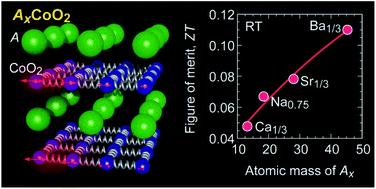Layered cobalt oxide epitaxial films exhibiting thermoelectric ZT = 0.11 at room temperature†
Abstract
Among many thermoelectric materials, oxide-based materials draw significant interest due to their environmental compatibility. In particular, layered cobaltite, Na0.75CoO2, shows a large thermoelectric power factor parallel to the layers. However, the thermal conductivity (κ) is rather high (5–7 W m−1 K−1), and therefore, its thermoelectric figure of merit ZT is small (∼0.03) at room temperature. Here we show that substituting the Na+ ion with the Ba2+ ion in NaxCoO2 drastically reduces the κ while keeping the large power factor, resulting in a large enhancement in ZT. We fabricated epitaxial films of Na0.75CoO2 by the reactive solid-phase epitaxy method and performed ion-exchange treatment from Na+ to Ba2+ to synthesize Ba0.27CoO2 films. The room temperature electrical conductivity (σ), thermopower (S), and power factor of the c-axis oriented Ba0.27CoO2 films along the in-plane direction were 2310 S cm−1, +72 μV K−1, and 1.2 mW m−1 K−2, respectively, while the κ along the in-plane, which was clarified by measuring the κ of the c-axis inclined (55°) film, was 3.3 W m−1 K−1. This yields a ZT (= S2σT/κ) value along the in-plane as high as 0.11 at room temperature, which is the highest among those reported for oxide thermoelectric materials except oxychalcogenide (BiO)(CuSe).



 Please wait while we load your content...
Please wait while we load your content...